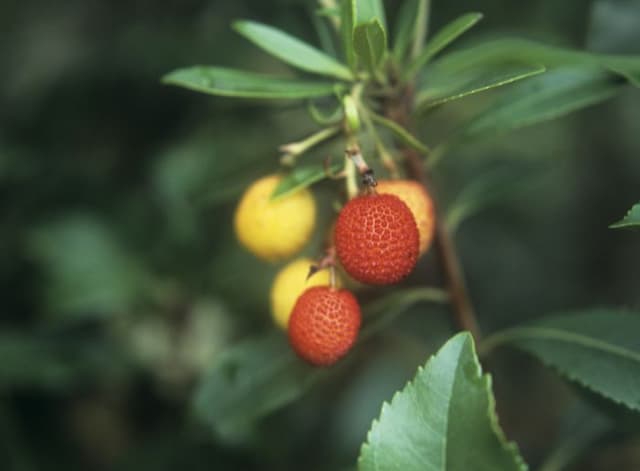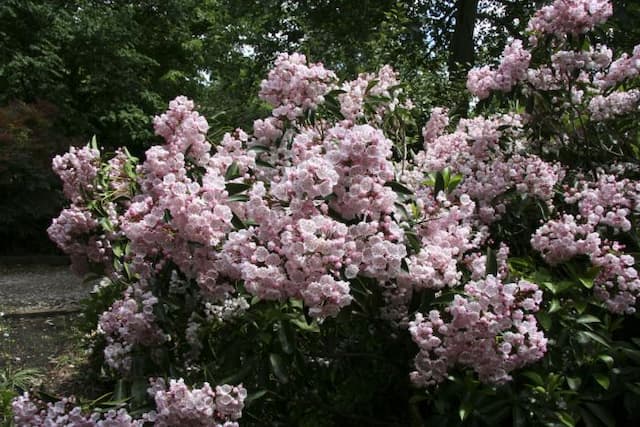Rhododendron Rhododendron ponticum

ABOUT
The Rhododendron ponticum, more commonly known as the Pontic rhododendron, is a plant distinguished by its lush, glossy, dark green leaves which are leathery to the touch. These evergreen leaves are oblong to lance-shaped and can span a considerable length, often appearing in whorls at the branch ends. The plant is renowned for its captivating floral display in spring and early summer when it produces large clusters of bell-shaped flowers. These flowers are typically a vibrant purple or lilac hue, but they can occasionally be found in pink or white variations. Each blossom is composed of a corolla with five petals, often spotted or blotched with deeper markings, which come together to form a striking contrast against the dense foliage. Furthermore, the Pontic rhododendron's flowers feature prominent stamens that protrude from the corolla, adding to the ornamental appeal of the blossoms. After the flowering period, the plant produces seed capsules that release numerous tiny seeds when mature. The overall presence of this rhododendron in a garden or natural setting is quite spectacular, primarily due to its robust foliage and the vibrant floral show it provides when in bloom. Despite its beauty, it is important to note that all parts of the plant are toxic if ingested.
About this plant
 Names
NamesFamily
Ericaceae
Synonyms
Pontic Rhododendron, Common Rhododendron, Pontic Azalea
Common names
Azalea pontica, Rhododendron lancifolium, Rhododendron speciosum.
 Toxicity
ToxicityTo humans
Rhododendron, which includes Rhododendron ponticum, is a toxic plant to humans. All parts of the plant contain toxic substances, primarily grayanotoxins. If ingested, these toxins can interfere with normal cell function and cause symptoms such as vomiting, diarrhea, hypersalivation, weakness, loss of appetite, abdominal pain, and potentially, progressive paralysis of limbs. In severe cases, ingestion can result in coma or death due to cardiovascular collapse. It is crucial to avoid consuming any part of the rhododendron plant.
To pets
Rhododendron is toxic to pets, including dogs, cats, and horses. The plant contains grayanotoxins, which can affect the animal's body when any part is ingested. Symptoms of rhododendron poisoning in pets can include drooling, vomiting, diarrhea, weakness, loss of appetite, abdominal pain, and in serious cases, severe cardiovascular problems, seizures, coma, or even death. It is critical to prevent pets from ingesting any part of the rhododendron plant.
 Characteristics
CharacteristicsLife cycle
Perennials
Foliage type
Evergreen
Color of leaves
Green
Flower color
Purple
Height
5 feet [1.5 meters]
Spread
7 feet [2.1 meters]
Plant type
Shrub
Hardiness zones
7
Native area
Asia
Benefits
 General Benefits
General Benefits- Erosion Control: Rhododendron ponticum has an extensive root system that can help stabilize soil and prevent erosion.
- Habitat Creation: The dense foliage offers shelter and nesting sites for various species of birds and other wildlife.
- Aesthetic Appeal: With its large, showy flowers and evergreen leaves, Rhododendron ponticum is widely used for ornamental purposes in gardens and parks.
- Pollinator Support: Its blooms provide a valuable nectar source for bees and butterflies during flowering season.
- Privacy Screening: Due to its thick and bushy habit, it is often used as a privacy screen or hedge in landscaping.
- Noise Reduction: The plant's density can help reduce noise pollution in urban and suburban settings when planted in large numbers.
- Coastal Protection: Rhododendron ponticum can survive in coastal environments, providing protection against sea winds and salt spray.
 Medical Properties
Medical Properties- This plant is not used for medical purposes
 Air-purifying Qualities
Air-purifying QualitiesThis plant is not specifically known for air purifying qualities.
 Other Uses
Other Uses- Honey source - Rhododendron ponticum can be used by bees to produce honey, although it should be noted that the plant contains grayanotoxins, which can lead to toxic honey if the bees ingest enough of the nectar.
- Ornamental Plant - In some regions, it has been used extensively as an ornamental plant in gardens and parks due to its large, attractive flowers and broad evergreen leaves.
- Habitat for Wildlife - It provides dense shelter for wildlife, although it is also known to displace native vegetation in some areas.
- Windbreaks - Its thick foliage and dense growing habit can be used to form windbreaks to protect more delicate plants or soil from erosion.
- Woodworking - The wood of Rhododendron ponticum is hard and can be used in turnery for making small items like handles and knobs.
- Fence Material - The branches can be bound together to create natural, rustic-looking fences in rural gardens or properties.
- Soil Erosion Control - Its root system helps stabilize soil in areas prone to erosion, although care should be taken due to its invasive potential.
- Privacy Screens - Due to its dense growth, it is often planted as a privacy screen between properties.
- Land Reclamation - It has been utilized in some countries for reforesting and reclaiming disturbed lands because of its robust nature.
- Education and Research - The plant is used as a case study in environmental science and ecology to understand the impact of invasive species in ecosystems.
Interesting Facts
 Feng Shui
Feng ShuiThe Rhododendron is not used in Feng Shui practice.
 Plant Symbolism
Plant Symbolism- Beware: Rhododendron ponticum, commonly known as the Rhododendron, can symbolize caution or danger due to the plant's poisonous nature.
- Abundance: With its lush, full blooms and expansive growth, the Rhododendron represents abundance and wealth.
- Beauty and Attraction: The vibrant, showy flowers of the Rhododendron symbolize beauty, elegance, and attractiveness.
- Homecoming: In certain cultures, the Rhododendron is a symbol of returning home or homeland, perhaps due to its natural habitat or significance within the region.
- Survival: The Rhododendron's ability to thrive in rocky and mountainous areas represents endurance, survival, and the overcoming of challenges.
 Water
WaterThe common Rhododendron should be watered thoroughly, ensuring the soil is moist but not waterlogged. It's typically best to water this plant once every week or two, depending on the weather conditions; during periods of drought or high temperatures, more frequent watering may be necessary. An average-sized Rhododendron may require about 1 gallon of water per watering session, but smaller plants will need less. Remember to water the base of the plant, avoiding wetting the foliage to prevent fungal diseases.
 Light
LightThe Rhododendron thrives in dappled sunlight or partial shade. It's best to avoid direct afternoon sunlight, which can scorch the leaves. The ideal spot for this plant would be under the canopy of tall trees that provide filtered sunlight or on the north side of a building where it can receive bright, indirect light throughout the day.
 Temperature
TemperatureRhododendrons prefer a temperate climate with temperatures ranging between 40 to 75 degrees Fahrenheit for optimal growth. They can survive minimum temperatures down to about 10 degrees Fahrenheit but may experience damage at lower temperatures. Conversely, prolonged exposure to temperatures above 80 degrees Fahrenheit can stress the plant.
 Pruning
PruningPruning Rhododendrons is important for promoting bushier growth and removing dead or diseased parts of the plant. The best time to prune is soon after the blooms fade in the spring, which encourages new growth for the next season. Pruning can be done annually, and light shaping of the plant can help maintain a desirable appearance.
 Cleaning
CleaningAs needed
 Soil
SoilRhododendron ponticum, commonly known as Pontic rhododendron, thrives best in a soil mix that is well-draining, moisture-retentive, and rich in organic matter. A recipe for an ideal soil mixture would be equal parts peat moss, pine bark, and perlite or coarse sand to ensure proper drainage. The optimal soil pH for Pontic rhododendron should be acidic, ranging between 4.5 to 6.0 for healthy growth.
 Repotting
RepottingPontic rhododendrons, or Pontic rhododendron, generally require repotting every two to three years to ensure they are not becoming root-bound and to refresh the soil. It is best done in late winter or early spring before new growth begins.
 Humidity & Misting
Humidity & MistingPontic rhododendron prefers moderate to high humidity levels, which should be maintained around 40-60% for optimal health; they do not thrive in arid or dry conditions.
 Suitable locations
Suitable locationsIndoor
Provide bright, indirect light and keep in cool temps for Pontic rhododendron.
Outdoor
Plant in dappled shade and keep soil moist for Pontic rhododendron.
Hardiness zone
5-8 USDA
 Life cycle
Life cycleRhododendron ponticum, commonly known as pontic rhododendron, begins its life cycle as a seed, requiring stratification to break dormancy and germinate, often in cool, moist conditions. Seedlings emerge and grow into juvenile plants, developing a root system and foliage as they become established. As the plant matures, it enters the vegetative stage, producing evergreen leaves and woody stems; this shrub can quickly form dense thickets in favorable conditions. Following vegetative growth, it reaches reproductive maturity, typically flowering from May to June, with showy purple blooms that attract pollinators such as bees. After pollination, flowers develop into capsule-like seed pods that release numerous tiny seeds, which disperse to produce new plants. In suitable environments, this rhododendron can become invasive, outcompeting native vegetation and perpetuating its life cycle aggressively.
 Propogation
PropogationPropogation time
Spring-Early Summer
Propogation: Rhododendron ponticum, commonly known as pontic rhododendron, is typically propagated through semi-hardwood cuttings. This method is most effective when performed in late summer. To propagate, select healthy semi-hardwood stems that are about 4 to 6 inches long (10 to 15 centimeters) and cut them just below a node. Remove the lower leaves to expose a length of bare stem and dip the cut end into a rooting hormone to encourage root development. The cuttings should then be placed in a mixture of peat and perlite, ensuring good contact between the cutting and the medium. Maintain high humidity and consistent moisture until roots have developed, which usually takes several weeks. Once rooted, the cuttings can be potted up individually and eventually moved to their permanent location.









